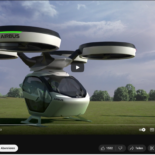Prototypes as Future Artifacts of Today
Towards Prototyping Alternative Futures
1_Introduction: Future Mobility Artifacts Today “Mobility is entering a new age of innovation,” claims McKinsey and forecloses future mobility with innovative vehicles, novel power sources, alternative transportation routines, or even fully redesigned transportation systems. [1] Other visions extend to futuristic hover-cars in the often envisioned glass-and-concrete world of the future, the gas-guzzling and people-maiming V8 engine in the not-so-ideal future of the Mad Max series, or the clean and omnidirectionally moving Audi from I Robot. These entire visions rest on the question of what practices we would want, or even could, connect to artifacts of future mobility: Would my car allow me to drive instead of it driving, presumably, more comfortably and safely? Or would cars be picking me up on demand and transporting me to a local city transport hub? Means of future-making embodied in prototypes are linked to current expectations and future imaginaries. Prototypical artifacts imply a future, yet their promise sits at the line between a possible future and a lived present. In other words, they not only materialize what the present is but also hint at what could come next. Through their inherent unfinished nature, they provide a glimpse into corresponding future scenarios. This hinting toward a future—connecting what is known with what is not known, yet possible—is the role that prototypes take in societies, and that makes investigating them and the past futures to which they belong so interesting. When Dickel describes the prototype as “both [...] an epistemic object that enables learning in situ and a materialized promise of a realizable future,” [2] he sensitizes us to a concept that goes beyond an “idea to be realized.” [3] Instead, it also carries an instructive component, a means to engage with a time to come in less abstract terms. This link to imaginaries is essential for prototypes. They build a bridge between representations of what is and vague promises of what could be. Prototypes invite us to imagine futures and related artifacts by creating a temporal bridge without giving exact instructions on how to get there. It is essential to point out that their manifestation may only occur embedded in prototypical situations, i.e., those constellations (design studio, real laboratory, exhibition, trade fair) in which they can be understood as prototypes. Such prototypical situations are characterized by offering a framing (pattern of interpretation) for understanding these artifacts as artifacts of the future, bridging the gap between…

